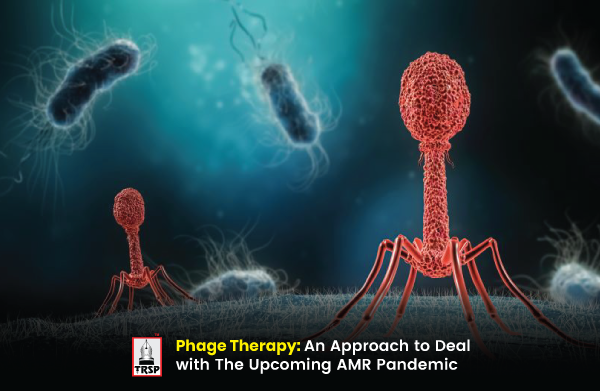Phage Therapy: An Approach to Deal with The Upcoming AMR Pandemic

Antimicrobial resistance (AMR) occurs when different microbes such as bacteria, viruses, fungi and other parasites mutate over time and are no longer treated by conventional antimicrobials hence increasing the rate of disease spread, severity and death. These kinds of microbes which developed resistance to antimicrobials are referred to as ‘Superbugs’. It might be unbelievable to you that antimicrobial resistance related bacterial infections are growing at a rate that more than 1.2 million people died as a direct result of AMR bacterial infections in 2019. If nothing changes, by 2050, more than 10 million people are expected to die from drug resistant diseases every year. So, it is certainly clear that the next pandemic will be AMR based and it is high time for us to find an alternative solution to deal with this. And Phage Therapy (PT) might be the solution we are looking for.
Phage Therapy (PT) is also known as bacteriophage therapy which uses viruses to treat bacterial infections. This virus are mainly known as phages or bacteriophages, specifically target and kill bacteria but humans are completely immune to them. Though phage therapy is in the race for more than 100 years, but still sounds new as treatment by using phages is only available on part scale. The French-Canadian microbiologist, Felix d'Herelle, claimed credit for discovering and naming bacteriophages. They are the most available biological entities on earth and phages could be found anywhere in the environment from soil to human gut microbiome where their host bacterium is available.
Primarily phages show two different life cycles in their host bacteria, a lytic cycle and a lysogenic cycle. Bacteriophages that lyse or destroy the host bacterium as they replicate are called lytic bacteriophages. And bacteriophages capable of a lysogenic life cycle don’t do lysis of the host bacterium; instead this type of phages can incorporate their DNA into the host bacterium's DNA. From this point of view, we could easily understand what kind of phages we need for therapy. Yes, you got it, our therapeutic phages must be in the lytic cycle so that the lysis of the pathogenic bacterium occurs.
Bacteriophages normally need a bacterial host to multiply or increase their number but without bacterial host phages remain in dormant state. And the number of new phages released from the lysis of bacterial host is known as the brust size which could be up to 1000 new phages per bacterium and vary among different phages. The new phages released from the host bacterium could infect another bacterium and the cycle goes on until hosts for phages are available. If no pathogenic bacterial host is available then the phages will remain dormant like other viruses and wait for more bacteria to appear. After a certain period of time phages will wash out from the body without harming the human and the non-pathogenic friendly microbiome. On the other hand, antibiotics are of two types depending on the types of bacteria they kill such as narrow spectrum or broad spectrum antibiotics. That means antibiotics are not very highly specific even if we used narrow spectrum antibiotics, it could kill both pathogenic and non pathogenic bacteria of the host. Here, the question is, is it possible for the bacterium to be non pathogenic and benefit the host? Yes, bacteria could be non-pathogenic and the human body contains 10 times more bacterial cells than human cells. Majority of them are good and human gut microbes known as the second brain. Antibiotics are becoming less sensitive to microbes even if they are working, it could kill both good and bad microbes and create an imbalance of microbiome in the human host. As a result, some side effects might occur such as upset stomach, nausea and vomiting, cramping, bloating and gassiness, diarrhea and also in some cases infection could last longer than expected or some secondary infection might also occur. These side effects could be avoided by phage therapy as it is highly specific to their host and does not attack others.
We already know that antibiotics are no longer working as bacteria gain resistance to it and also they could spread the resistant gene among them and their related species. It mainly occurred due to the misuse of antibiotics as antibiotics work in a dose dependent manner that means to kill the pathogenic bacterium we must maintain a certain concentration in the body fluid. Most of the cases antibiotics are used without any prescription and even if it is used according to the doctor's prescription, proper dose or course is not maintained ultimately resistance arised. But as phages could increase their number simultaneously depending on their specific host and when host is not available it will remain dormant so it could be predicted that no resistance would occur for not maintaining proper dose. So one dose of phages might be enough to treat any bacterial infection.
So aren't there any difficulties or dark side for developing phage therapeutics? Nothing in this world is crystal clear or free of side effects. Finding the specific phages that could target the pathogenic bacterium which is responsible for the infection might take longer time than expected. Without finding the proper bacteriophages that could infect the pathogenic bacterium, it is not possible to start the treatment procedure. In that case, bio-engineered phages or phage modification might reduce the timeline for phage selection. We already know that only the lytic phages could cause the lysis to kill the bacterium, but in contrast the lysogenic phages don’t do lysis; instead they integrate their genome into the bacterial genome. This genome might contain an antimicrobial resistance gene or some virulence gene such as a toxin producing gene. So there is a chance that if we couldn’t use the proper phages then the disease conditions might get worse as bacteria could acquire some virulence genes and become more resistant.
Phages are highly specific to their targeted host bacteria, which means their target range is very narrow. This problem can be overcome by using mixtures of phages or bio-engineered phages that can attack multiple pathogenic bacterium. Another problem is very little information is available about the pharmacokinetics and pharmacodynamics of phages as in case of drugs antibiotics concentration will decrease after administering into the body, but phage numbers increase as they multiply. As more information becomes available from the phage trial, this problem will be overcome. Lastly, It is not impossible for bacteria to develop resistance against phages so the patients must be continuously monitored. But development of resistance is not always a bad thing as phage resistant bacteria might become susceptible to previous antibiotics. So, the combination of phage therapy and antibiotics could increase the efficiency and efficacy of the phage therapy. In the future, bio-engineered phages might deliver CRISPR-Cas systems to their bacterial host which will help to kill bacteria more robustly and also increase specificity and efficiency of their killing.
It might be a weird concept to use viruses as a cure, but the era of using antibiotics as a super weapon is drowning to an end, and we have to come up with a better solution and phage therapy could be the one we are looking for. Finally, Phage therapy could be recommended as nature’s “antibiotics” and might be a valuable alternative treatment to deal with AMR pandemic.
Reference
• Brives, C., Pourraz, J. Phage therapy as a potential solution in the fight against AMR: obstacles and possible futures. Palgrave Commun 6, 100 (2020)
- https://trsp.link/eI0xNzdR
- https://trsp.link/9TqrjdsJ
- https://trsp.link/uENlqvzI
- https://trsp.link/AIoPclqn
Dipta Chandra Pal
Microbiology, University of Dhaka

